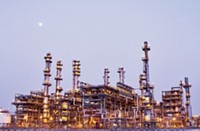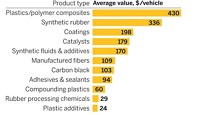Advertisement
Grab your lab coat. Let's get started
Welcome!
Welcome!
Create an account below to get 6 C&EN articles per month, receive newsletters and more - all free.
It seems this is your first time logging in online. Please enter the following information to continue.
As an ACS member you automatically get access to this site. All we need is few more details to create your reading experience.
Not you? Sign in with a different account.
Not you? Sign in with a different account.
ERROR 1
ERROR 1
ERROR 2
ERROR 2
ERROR 2
ERROR 2
ERROR 2
Password and Confirm password must match.
If you have an ACS member number, please enter it here so we can link this account to your membership. (optional)
ERROR 2
ACS values your privacy. By submitting your information, you are gaining access to C&EN and subscribing to our weekly newsletter. We use the information you provide to make your reading experience better, and we will never sell your data to third party members.
Sustainability
Chemical Outlook 2015 By Region
January 12, 2015
| A version of this story appeared in
Volume 93, Issue 2
Jump to Topics:
- U.S.: Feedstock advantage to bring steady growth in 2015
- Europe: Lower oil price eases region’s woes
- Asia: Oversupply and slower growth will hurt profit margins for region’s firms
- Canada: Companies had a great 2014, but they don’t expect a repeat performance
- Middle East: The competitive heat will rise in 2015
- Latin America: Reform may lead to chemical industry growth in the region

With the U.S. awash in low-cost natural gas and petroleum, the forecast for the chemical industry is bright. “The consensus is that U.S. chemical output will improve during 2015 and into the second half of the decade,” says T. Kevin Swift, chief economist at the American Chemistry Council, a trade group.
Indeed, ACC expects chemical production to increase 4.0% this year, compared with 2.4% in 2014 and 3.0% for the overall U.S. economy this year. In addition, making chemicals will be more profitable in 2015. In December, for example, Dow Chemical told investors that the low cost of natural gas compared with crude oil will add $2.5 billion per year to its earnings.
The shale gas revolution has turned the U.S. into a great place to make chemicals, and it’s now the key investment location for the world’s chemical companies. So far, Swift has tallied 215 new chemical projects planned by firms from around the globe, which will add up to roughly $135 billion in capital spending. Much of it is along the U.S. Gulf Coast.
But shortages of material and skilled labor, coupled with the recent plunge in oil prices, may put a wobble into some of the more ambitious plans for expansion, cautions Michael J. Shannon, head of chemicals and performance technologies at consultancy KPMG.
New chemical facilities won’t make a mark on overall capacity until about 2017. In the meantime, the plunge in gasoline prices will help to rev up consumer spending, while lower energy and feedstock prices will jump-start U.S. manufacturing more broadly, Swift notes. As a result, at Dow and other U.S. firms, operating rates are expected to tick up significantly this year.
What’s less clear is the strength of demand for consumer products, automobiles, and houses made with chemicals. Analysts agree that the export market will be important but question the spending power of weakened trading partners such as Japan, Brazil, and Europe.

In the U.S., signs point to increased consumer demand, thanks to a rebound in home values and employment rates. Production of light vehicles in North America this year should increase by 3.0% to 17.4 million units, according to LMC Automotive, an industry forecaster. And the National Association of Home Builders expects single-family home starts to jump 17%.—Melody Bomgardner
The collapse of the global oil price to around $60 per barrel should provide some relief this year for Europe’s chemical firms, which in many markets are losing out to competitors from the Middle East and the U.S.
“The lower oil price will obviously have a beneficial impact for the European chemical industry: You can see already that margins are picking up in Europe,” says Paul Hodges, chairman of U.K. consulting firm International eChem.
Although margins may be improving, experts don’t anticipate a rapid rise in sales and production. “We now expect EU chemical production to grow again by 1.0% in 2015, against 1.5% foreseen earlier,” says Moncef Hadhri, chief economist for CEFIC, Europe’s largest chemical industry association.
The outlook is similar in Germany, Europe’s biggest chemical producer. “Demand continues to rise in Europe, our most important market outside Germany,” says Marijn E. Dekkers, who is chairman of Bayer and president of VCI, a German chemical industry organization. “Business with the U.S.A. is turning out to be very good.” But overall, the chemical industry in Germany is set to grow a modest 1.5% this year.
Indeed, continued lackluster growth has led to a declining role for Europe in the world chemical marketplace. According to a report by English consulting firm Oxford Economics, Europe’s share of the global chemical business has declined from 32% in 1993 to 17% in 2013 and will continue to shrink unless the region’s energy policy is overhauled and there is a marked hike in R&D investment.
The introduction of a “coordinated, competitive energy policy” featuring a single European energy market could save the sector $43.5 billion annually, Oxford Economics states. The frustration for CEFIC and its members is that European energy policy is steeped in politics and, analysts say, coordination will not happen anytime soon.

In lieu of an energy revamp, “there is quite a bit of restructuring that has to be gone through,” Hodges says. “We need to move to more of a hub-and-spoke kind of operation where we focus on a few areas and we make sure we have the most robust value chains possible. We don’t have that at the moment. There’s quite a bit of structural and organizational change that needs to be done—and pretty urgently—in the next two or three years.” —Alex Scott
Asian producers of major industrial chemicals will struggle in 2015 as the economies of Japan and China slow. The industry will also be harmed by overcapacity in China and the global fall in oil prices.
“Falling oil prices translate into decreasing prices for chemicals,” says an account manager responsible for China at Taiwan’s Formosa Plastics. “Buyers in China are delaying their purchases because they figure they can buy at a lower price later.” The manager asked not to be identified because he’s not authorized to speak for the company.
Of course, a time will come when buyers in China have to rebuild their stocks, the salesman acknowledges. But profit margins in the industry will likely not improve for several months, perhaps not before the second half of 2015, he reckons.
Adding to problems, the industry is struggling with capacity overbuilding in China that has been dampening margins for some time. The overexpansion hit Chinese oil and petrochemical giant Sinopec, which reported an operating loss of $560 million for the first nine months of the year. “Competition from imported chemical products and the increase of newly added domestic production capacity posed a great challenge to domestic producers,” Sinopec noted at the end of October.
The outlook is a little better in Japan. Companies that produce materials for the electronics industry, for instance, should enjoy a relatively good year. However, as in China, the outlook is poor for basic chemicals. This is partly because economic growth in Japan slowed after the government raised its consumption tax last spring.
“A mood of uncertainty is growing because of fluctuations in exchange rates and crude oil prices, changes in the taxation system including the consumption tax, and concerns about rises in electricity rates,” the Japanese chemical maker Showa Denko said last month.
In contrast, Asia’s third-largest economy, India, will likely be a bright spot in 2015. The Asian Development Bank expects that economic growth in India will accelerate to 6.3% in 2015 because of improved business and consumer sentiment following the election of a new government.

Reliance Industries, India’s largest refiner and petrochemical producer, achieved record profits in the first half of the fiscal year that ends March 31. When releasing the results, Reliance said it expects supportive business conditions throughout 2015.—Jean-François Tremblay
For the first time, Canadian chemical producers last year tapped into the U.S. shale gas advantage.
In 2014, Nova Chemicals’ ethylene cracker in Sarnia, Ontario, celebrated its first ethane supplies from the Marcellus Shale formation in Pennsylvania. The company had long wanted to wean itself from a naphtha diet that was increasingly making the cracker uneconomical. The new gas could allow Nova to proceed with polyethylene capacity expansion nearby.
Across the country in Alberta, Nova saw the opening of a pipeline that is bringing ethane up from North Dakota’s oil-rich Bakken formation.
Until 2014, ethane had been cheap but hard to come by in Canada. Low-cost U.S. natural gas meant more muted Canadian production of gas and, by extension, less ethane available for Canadian ethylene crackers. The pipelines are a long-term fix to this problem.
Cheaper feedstocks and a better economy meant a banner year in 2014 for the Canadian industry. According to the Chemistry Industry Association of Canada (CIAC), sales for the country’s industrial chemical makers jumped 10% to $26.5 billion, a record level. Operating profits also rose 10% to reach an unprecedented $3.6 billion.
This year’s outlook isn’t as rosy. On the basis of a member survey, CIAC expects sales to decline 7% in 2015. Members anticipate profits will fall by 2%.
“There is a bit of negativity in the report in terms of the outlook for sales, but a lot of positive things to take from it, too, in terms of profit outlook and investment outlook,” notes John Margeson, director of business and economics for CIAC.
For example, even with the decline in profits, the Canadian chemical industry is still looking forward to the second-most-profitable year in its history. Moreover, capital expenditures are set to increase by 31% to a record $3.1 billion. Nova’s investments are a big part of that number.

And Dave Podruzny, CIAC vice president of business and economics, notes that more than half of the expected 7% sales decline will be due to lower prices of chemical products. “Now with the severe change in oil prices, most of what is being forecast for next year is going to be price related,” he notes.—Alex Tullo
The growth rate of the chemical industry in the Middle East, which represents 7% of global petrochemical capacity, is declining. Three key factors are in play, according to the consulting firm McKinsey & Co.: Global competition is strengthening, planned manufacturing capacity appears set to outstrip the availability of cheap natural gas in the region, and key markets for Middle Eastern chemicals, such as China, are making themselves self-sufficient.
Growth in chemical production in the Gulf Cooperation Council region, where much of the Middle East’s chemical industry is located, is set to slip to an average rate of 7.1% per year through 2020, down from 11.0% annually in recent decades, says the Gulf Petrochemicals & Chemicals Association (GPCA), the region’s leading industry association.
GPCA predicts that the emergence of low-cost hydrocarbons in the U.S. will be one of its major competitive threats. “North American chemicals will double in the next decade, giving them capabilities to be in markets that we thought were traditionally ours,” said Khalid A. Al-Falih, chief executive of Saudi Aramco, at the GPCA Annual Forum in Dubai last November.
Meanwhile, after years of enjoying a natural gas surplus, the region may experience a gas shortage that could be felt anytime from 2015 onward, McKinsey warns. Measures that Middle East chemical firms could take to offset the shortage include the adoption of mixed-feed crackers, methanol-to-olefins technology, and crude-to-chemicals processes, the consulting firm states.
Companies are also responding by diversifying from commodity chemicals into specialty chemicals, according to Aparajith Balan, a Middle East program manager at Frost & Sullivan, a market research firm.
But a diversification strategy is not without its pitfalls, Balan warns. “While the Middle East has access to most of the essential industrial resources like raw materials, utilities, and human resources, it falls short of the advanced technologies that are required to make manufacturing possible,” he says.

Local companies are attempting to address this problem by stepping up R&D activity. Saudi Basic Industries Corp., for example, says it more than tripled the rate at which it applied for patents in 2014 compared with 2010.—Alex Scott
This year, the first new North American ethylene cracker to be built in more than a decade is set to open on the Gulf Coast … of Mexico.
Etileno XXI, a $4.5 billion ethylene-polyethylene joint venture between Brazil’s Braskem and Mexico’s Grupo Idesa, could be a sign of things to come for the Mexican chemical industry. Private initiative is beginning to make up for decades of underinvestment during which Mexico’s state oil company, Pemex, held a monopoly in basic chemicals.
Advertisement
New laws are liberating the rest of the hydrocarbon sector as well. Last year, Mexican President Enrique Peña Nieto signed an energy reform package into law that loosens Pemex’s grip on the country’s oil and gas. Private energy investment may free up more feedstocks for potential petrochemical projects.
Argentina is also trying to unlock its hydrocarbon potential. According to the state oil company YPF, Argentina is second only to the U.S. in global shale gas reserves. The company invested $1.1 billion in unconventional oil and gas recovery in 2013. Already, shale accounts for 10% of its gas production.
Dow Chemical, which cracks ethane at its complex in Bahia Blanca, Argentina, has much to gain if shale gas takes off there as it has in the U.S. Dow is “making a lot of money,” says Jorge Bühler-Vidal, president of North Brunswick, N.J.-based Polyolefins Consulting. The ethane is cheaper than the naphtha feedstock used in most of the region, and the company doesn’t have to pay high tariffs if it exports polymers to neighboring Brazil.
However, price controls in Argentina divert natural gas away from industrial use and toward home heating in winter months, sometimes leaving Dow without adequate supplies. More gas availability could enable Dow to run flat out and eventually expand, Bühler says.
Overall, Latin America’s major economies are expected to perform better in 2015 than they did in 2014, but they likely won’t shake off their slump of the past couple of years. The International Monetary Fund (IMF) expects Brazil to grow by 1.4% in 2015, versus 0.3% in 2014. Argentina’s economy will shrink 1.5% in 2015, versus a 1.7% contraction in 2014.
↑ Top
Jump to Topics:
- U.S.: Feedstock advantage to bring steady growth in 2015
- Europe: Lower oil price eases region’s woes
- Asia: Oversupply and slower growth will hurt profit margins for region’s firms
- Canada: Companies had a great 2014, but they don’t expect a repeat performance
- Middle East: The competitive heat will rise in 2015
- Latin America: Reform may lead to chemical industry growth in the region
“A modest recovery is projected for 2015, yet risks remain tilted to the downside as many economies struggle to find new engines of sustainable growth in an environment of stagnant commodity prices and more binding supply bottlenecks,” IMF says.—Alex Tullo





Join the conversation
Contact the reporter
Submit a Letter to the Editor for publication
Engage with us on Twitter